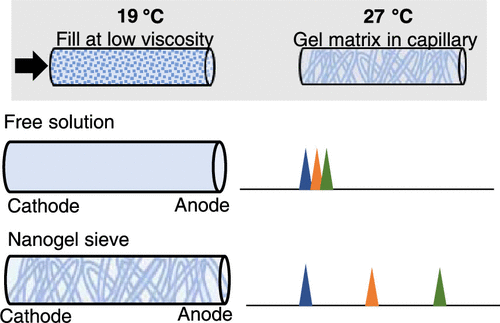当前位置:
X-MOL 学术
›
Anal. Chem.
›
论文详情
Our official English website, www.x-mol.net, welcomes your
feedback! (Note: you will need to create a separate account there.)
Protein Sieving with Capillary Nanogel Electrophoresis
Analytical Chemistry ( IF 6.7 ) Pub Date : 2020-12-31 , DOI: 10.1021/acs.analchem.0c03865 Cassandra L. Crihfield 1 , Lisa A. Holland 1
Analytical Chemistry ( IF 6.7 ) Pub Date : 2020-12-31 , DOI: 10.1021/acs.analchem.0c03865 Cassandra L. Crihfield 1 , Lisa A. Holland 1
Affiliation

|
Protein sieving, which is a fundamental tool in the biotechnology field, can be automated using capillary gel electrophoresis. The high-viscosity and biocompatible linear gels required for capillary sieving must be replaced for each run using high pressures. Thermally responsive gels are easier to renew in the capillary as they can be repetitively switched between low- and high-viscosity solutions. A thermally responsive sieving gel was recently demonstrated to separate DNA, which is a larger biomolecule than proteins. This material required no synthesis as it was self-assembled from common phospholipids. Nanogels composed of dimyristoyl-sn-glycero-2-phosphocholine and 1,2-dihexanoyl-sn-glycero-3-phosphocholine exhibit thermally reversible viscosity within a 10 °C temperature change, forming a sieving matrix above 24 °C. Additionally, these nanogels are nondenaturing and have been demonstrated to preserve the activity of enzymes. In this report, a phospholipid nanogel is used for the first time for capillary gel electrophoresis separations of proteins. The mobilities in buffer and nanogel demonstrated that 20–30% nanogel supports sieving of proteins ranging from 20 to 80 kDa. Capillary separations based on sieving rather than electrophoresis had similar precision in both area and migration time as well as similar separation efficiencies. However, the migration time increased with gel concentration. The nanogel was used for the analysis of proteins in human serum. Proteins in the sample were more effectively resolved and quantified with capillary sieving compared to free-solution capillary electrophoresis. This allowed for accurate quantification.
中文翻译:

毛细管纳米凝胶电泳筛分蛋白质
蛋白质筛分是生物技术领域的基本工具,可以使用毛细管凝胶电泳自动进行。每次使用高压操作时,都必须更换毛细管筛分所需的高粘度和生物相容性线性凝胶。热响应性凝胶更容易在毛细管中更新,因为它们可以在低粘度和高粘度溶液之间反复切换。最近证明,热响应筛分凝胶可分离DNA,而DNA是比蛋白质更大的生物分子。该材料不需要合成,因为它是由常见的磷脂自组装而成的。由二肉豆蔻酰基-sn-甘油-2-磷酸胆碱和1,2-二己酰基-sn组成的纳米凝胶-甘油-3-磷酸胆碱在10°C的温度变化内表现出热可逆的粘度,在24°C以上形成筛分基质。另外,这些纳米凝胶是非变性的,并且已经证明可以保留酶的活性。在此报告中,磷脂纳米凝胶首次用于蛋白质的毛细管凝胶电泳分离。缓冲液和纳米凝胶中的迁移率表明,20%到30%的纳米凝胶支持筛分20至80 kDa的蛋白质。基于筛分而不是电泳的毛细管分离在面积和迁移时间上均具有相似的精度,并且具有相似的分离效率。但是,迁移时间随凝胶浓度而增加。纳米凝胶用于分析人血清中的蛋白质。与自由溶液毛细管电泳相比,通过毛细管筛分可以更有效地分离和定量样品中的蛋白质。这样可以进行准确的定量。
更新日期:2021-01-26
中文翻译:

毛细管纳米凝胶电泳筛分蛋白质
蛋白质筛分是生物技术领域的基本工具,可以使用毛细管凝胶电泳自动进行。每次使用高压操作时,都必须更换毛细管筛分所需的高粘度和生物相容性线性凝胶。热响应性凝胶更容易在毛细管中更新,因为它们可以在低粘度和高粘度溶液之间反复切换。最近证明,热响应筛分凝胶可分离DNA,而DNA是比蛋白质更大的生物分子。该材料不需要合成,因为它是由常见的磷脂自组装而成的。由二肉豆蔻酰基-sn-甘油-2-磷酸胆碱和1,2-二己酰基-sn组成的纳米凝胶-甘油-3-磷酸胆碱在10°C的温度变化内表现出热可逆的粘度,在24°C以上形成筛分基质。另外,这些纳米凝胶是非变性的,并且已经证明可以保留酶的活性。在此报告中,磷脂纳米凝胶首次用于蛋白质的毛细管凝胶电泳分离。缓冲液和纳米凝胶中的迁移率表明,20%到30%的纳米凝胶支持筛分20至80 kDa的蛋白质。基于筛分而不是电泳的毛细管分离在面积和迁移时间上均具有相似的精度,并且具有相似的分离效率。但是,迁移时间随凝胶浓度而增加。纳米凝胶用于分析人血清中的蛋白质。与自由溶液毛细管电泳相比,通过毛细管筛分可以更有效地分离和定量样品中的蛋白质。这样可以进行准确的定量。











































 京公网安备 11010802027423号
京公网安备 11010802027423号